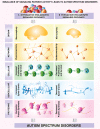Characterizing autism spectrum disorders by key biochemical pathways
- PMID: 26483618
- PMCID: PMC4586332
- DOI: 10.3389/fnins.2015.00313
Characterizing autism spectrum disorders by key biochemical pathways
Abstract
The genetic and phenotypic heterogeneity of autism spectrum disorders (ASD) presents a substantial challenge for diagnosis, classification, research, and treatment. Investigations into the underlying molecular etiology of ASD have often yielded mixed and at times opposing findings. Defining the molecular and biochemical underpinnings of heterogeneity in ASD is crucial to our understanding of the pathophysiological development of the disorder, and has the potential to assist in diagnosis and the rational design of clinical trials. In this review, we propose that genetically diverse forms of ASD may be usefully parsed into entities resulting from converse patterns of growth regulation at the molecular level, which lead to the correlates of general synaptic and neural overgrowth or undergrowth. Abnormal brain growth during development is a characteristic feature that has been observed both in children with autism and in mouse models of autism. We review evidence from syndromic and non-syndromic ASD to suggest that entities currently classified as autism may fundamentally differ by underlying pro- or anti-growth abnormalities in key biochemical pathways, giving rise to either excessive or reduced synaptic connectivity in affected brain regions. We posit that this classification strategy has the potential not only to aid research efforts, but also to ultimately facilitate early diagnosis and direct appropriate therapeutic interventions.
Keywords: ERK signaling; MAP kinase signaling system; autism spectrum disorders (ASD); mTOR pathway; neurotrophic factors; protein synthesis.
Figures

References
-
- Anderson J. S. (2014). Cortical underconnectivity hypothesis in autism: evidence from functional connectivity MRI, in Comprehensive Guide to Autism, eds Patel V. B., Preedy V. R., Martin C. R. (New York, NY: Springer Science+Business Media; ), 1457–1471. 10.1007/978-1-4614-4788-7_81 - DOI
Publication types
Grants and funding
LinkOut - more resources
Full Text Sources
Other Literature Sources
Miscellaneous

